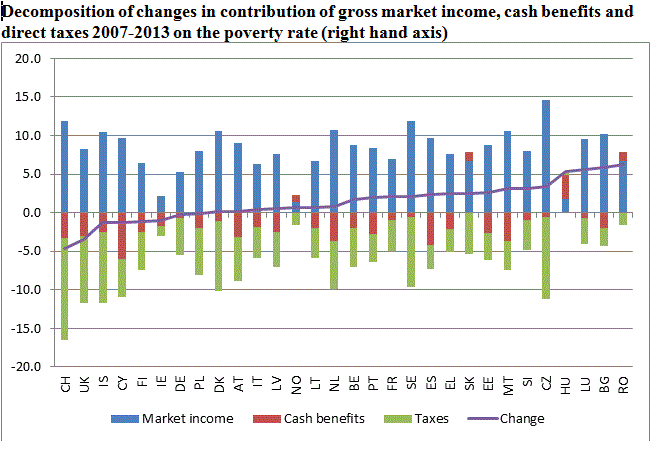Jonathan
Bradshaw and Oleksandr Movshuk
Social and fiscal policy was used in European countries to mitigate the impact unemployment and falling real wages on child poverty that followed the global crisis. This is shown by comparative
decompositional analysis of changes in child poverty in
working age households over the recession using EU-Statistics on Income and
Living Conditions (EU-SILC) data between 2008 and 2014 (incomes in 2007 and 2013) in the figure below. The
decomposition uses national currencies rather than purchasing power parities in
order to avoid the impact of severe fluctuations in exchange rates in some countries over the period. The figure shows the change in the contribution to the poverty rate (less than 60% median equivalent income) of reductions in gross market income and how these were mitigated (or exacerbated) by changes to direct
taxes and cash benefits over the period.
In all countries changes in market
income increased poverty as a result of unemployment and decreased earnings. However in ten countries cuts or reductions in
direct taxes and or improvements or increases in cash benefits mitigated this effect and
there was no overall increase in child poverty. However child poverty increased in all the
other countries and in Norway, Slovakia, Hungary and Romania this was partly
because cash benefits fell (or became less effective) over the period. In most countries reductions in direct taxes paid was more important in reducing child poverty than increases in benefits received.
This analysis really only takes us up to the start of the recession as many countries were still mired in deficit reduction in 2013.
For example we can certainly expect that the UK
will be joining the group of countries with increases in child poverty due to the cuts in working age benefits that
have been made since 2013. The Institute
for Fiscal Studies expects UK relative child poverty to increase from 19%
in 2014/15 to 27% in 2021/22 before housing costs and from 29% to 36% after
housing costs.

